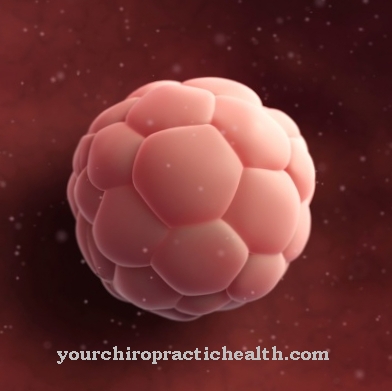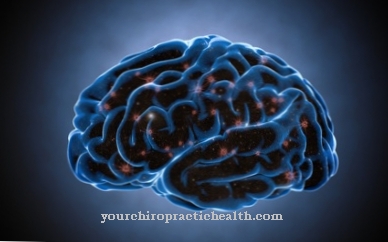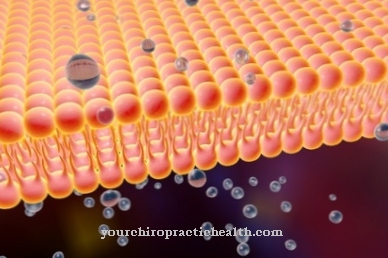Of the Vascular resistance is defined by the physical resistance of a capillary, vein or artery that is opposed to the flowing blood. Vascular diseases can affect the entire organism but also a single organ such as the heart or the brain. In any case, the first warning signals must be observed in order to be able to counteract a serious course of the disease that can also be fatal.
What is vascular resistance?

The vascular resistance in the individual vessel sections is not identical, but different. The dynamic control takes place through the circulatory system.
If the definition of resistance relates to a single organ, a distinction is made between coronary, pulmonary and cerebral vascular resistance.
Function & task
The coronary vascular resistance consists of a vascular and an extravascular component. The vasal provides most of the physical regulation of coronary blood flow. The extravascular is based on mechanical stress exerted by myocardial contraction and relaxation.
Pulmonary vascular resistance (PVR) refers to the resistance in the pulmonary circulation. This begins in the pulmonary artery and extends into the atrium of the left heart. It is not accessible for clinical measurement, which is why the pulmonary capillary closure pressure is used approximately to determine the pulmonary resistance. In the professional world is also from Wedge print (PAP) spoken. In addition, pulmonary vascular resistance is divided into acute pulmonary hypertension and chronic pulmonary hypertension.
The cerebral vascular resistance is the flow resistance that the brain vessels oppose the blood flow and that is driven by systemic blood pressure. In this way, blood flow to the brain is regulated.
Illnesses & ailments
Some of the major diseases associated with vascular resistance include:
Coronary heart disease (CHD): It is caused by insufficient blood flow to the heart muscle, which means that the oxygen and nutrient requirements are not ensured. The cause is often arteriosclerosis in the coronary arteries. Coronary heart diseases include angina pectoris, myocardial infarction and sudden cardiac death. Plaques are to blame. These are fatty deposits that block all or part of the blood flow.
The pulmonary vascular diseases:
We are mostly talking about pulmonary embolism (pulmonary embolism). The obstruction of a pulmonary artery by blood clots is responsible for this disease. Usually a leg vein thrombosis precedes it.
Primary pulmonary hypertension:
Its incidence is around 1.1,000,000, which is why this clinical picture is one of the very rare. The exact cause is also not yet known.
Secondary pulmonary hypertension:
It usually occurs as a result of another underlying disease. In order to protect the lungs, this underlying disease must therefore be treated as a priority. This is the only way to control and regulate pulmonary high pressure.
Acute pulmonary hypertension:
The pulmonary vessels are constricted here. This often only exists temporarily in the early stages. For example under stress. The radius of the vessels is reduced by the contraction of the vascular muscles, which leads to an increase in blood pressure.
Chronic pulmonary hypertension:
In this case, remodeling of the pulmonary vessels can be diagnosed. The vascular muscles increase in size before they slowly transform into connective tissue. The pulmonary vessels are then less flexible and cannot regain their flexibility.
If sclerosis is added, the condition of those affected worsens. The lungs are no longer properly ventilated, which over time leads to an increasing lack of oxygen in the lungs. Another consequence of this clinical picture is the continuous reduction in cardiac output.
The cerebral vascular diseases: Apoplexy (stroke) as a sudden event ranks among the 3 most common causes of death. 40-50% of the causes are a thrombosis, 30-35% an embolism and in 20-25% of the cases a cerebral hemorrhage, triggered by blood leakage from a cerebral artery. High blood pressure and a reduced ability of the blood to clot are beneficial. This also applies to intracerebral venous congestion. For example, a sinus vein thrombosis.
Vascular diseases of the brain and spinal cord: It is not uncommon for aneurysms to occur in the brain and spinal cord. This is the result of pathological changes in the arteries (arterial walls). These are located on the surface of the brain or the spinal cord. The size of an aneurysm can range from a few millimeters to 50 millimeters in diameter. The triggers include not only atherosclerotic changes in the aneurysm wall. A disturbed blood flow or blood pressure are also possible. In addition, genetic or inflammatory vascular injuries or vascular changes can be the cause.
Symptoms include an extremely severe headache, which may be accompanied by nausea and vomiting. The following complaints can be found in pulmonary hypertension observe: The vast majority of those affected experience dyspnea (breathlessness, shortness of breath). A poor general condition, circulatory disorders up to syncope (circulatory collapse) and angina pectoris (chest tightness) occur in almost every second patient. Symptoms such as tiredness and the formation of edema (swelling) are also common. On the other hand, cyanosis (blue-violet coloration of the fingertips, lips or skin) and Raynaud's syndrome (temporary circulatory disorders) occur less frequently.



























